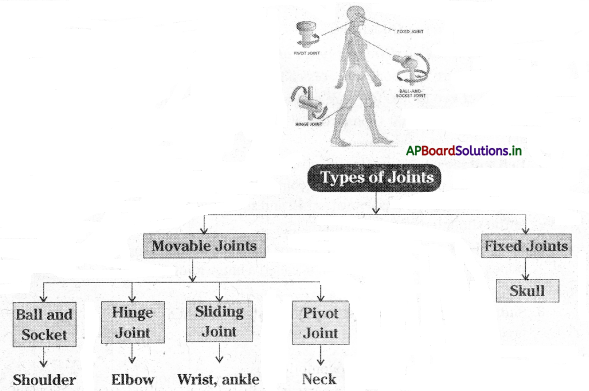Students can go through AP State Board 6th Class Science Notes Chapter 12 Movement and Locomotion to understand and remember the concept easily.
AP State Board Syllabus 6th Class Science Notes Chapter 12 Movement and Locomotion
→ Organisms show moments and locomotion.
→ The displacement of a body or its parts from its original position is called movement.
→ The displacement of an entire body from one place to another is called locomotion.
→ Locomotion helps for protection and food gathering.
→ Different muscles of our body perform different functions.
→ Muscles are connected to bones either directly or with the help of tendons.
→ Muscles work in pairs. When one of them contracts, the bone is pulled in that direction and the other muscle of the pair relaxes.
→ Different bones of our body combine together to form the skeleton.
→ The point where two bones meet is called a joint.
→ Joints are of two types. They are movable and immovable (fixed).
→ Movable joints are four types namely 1. Ball and socket 2. Hinge 3. Sliding 4. Pivot joints.
→ Tendons join muscles to bones.
→ Ligaments join one bone to the other bone.
![]()
→ Our backbone works like a spring.
→ The joint between the upper jaw and the skull is the fixed joint.
→ The stream-lined body, fins in fish; wings, legs in birds; ribs in the snake; muscular foot in the snail are useful in locomotion.
→ Bones: Bone is the hard tissue that provides a base to the body and forms the skeleton.
→ Muscles: Muscles are soft tissue that provides the shape of the body and helps in motion.
→ ligament: A ligament is the fibrous connective tissue that connects bones to other hones.
→ Tendon: Fibrous connective tissue that connects muscle to bone.
→ Cartilage: Flexible smooth hone present in the tip of nose and ear.
→ Clavicle: It is also known as collar bone, it is a long bone between the neck and the shoulder blade.
→ Pelvic GIrdle: Circular structure of the bone present at the waist where the leg bones are joined.
→ Ball and socket joint: The rounded end of one bone fits into the hollow end of the other hone. Such a joint allows movement in all directions. This joint is known as the ball and socket joint.
→ Hinge joint: Like the hinge of a door, the joint which helps the hones to move in one direction is called a hinge joint.
→ Sliding joint: The joint where the bones slide over eaçh other is called the sliding joint.
![]()
→ Pivot joint: The joint that joins the skull to the backbone is called the pivot or neck joint.
→ LocomotIon: It is the displacement of the entire body from one place to another place.
→ Movement: It is a temporary or permanent displacement of a body or its parts from its original position.
→ Back Bone: A long structure running down the middle of his back is called the backbone.
→ Vertebrae: hie small bones that make up this backbone are called vertebrae.
→ Spinal Card: Spinal cord passes is a nerve part that travels through the vertebrae of the backbone.
→ Joints: The point where two bones meet is called a joint.
→ Fixed Joints: The joints between the skull bones are fused. They are also called fixed joints.
→ Ribs: Bones that are located in the chest area.
![]()
→ Rib case: Ribs are bent which joins the chest hone and the backbone together to form a box. This is called the rib cage.
→ Joint: The point where two bones meet is called a joint.

→ There are more than 650 muscles in our body. The biggest muscle is Gluteus-Maxiirnis and the smallest muscle is Stapedius. Interestingly the muscle of the heart works Without rest. The human heart forces 4500 ccs of blood per minute through blood vessels.
→ There are 206 bones present in our body. These bones are so hard due to the presence of calcium and phosphorus. The biggest bone is the femur and the smallest bone is the stapes.